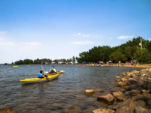Today the last day to prune elm trees until the Fall
By Delon Shurtz - Lethbridge Herald on March 31, 2023.
LETHBRIDGE HERALDdshurtz@lethbridgeherald.com Lethbridge residents who are planning to prune their elm trees have to do it today, or wait another six months.The province-wide pruning ban for all species of elm trees takes effect Saturday, and won’t be lifted until Sept. 30 when elm bark beetles and Dutch Elm Disease are no longer a threat.
Pruning elm trees during the summer provide entry sites for elm bark beetles, which carry the disease fungus and can infect, and ultimately kill, a healthy tree. The beetles fly to stressed or injured elm trees, spreading the disease as they go.
Anna Larney, urban forest technician for the City of Lethbridge, says because the disease is easily spread, it’s critical residents adhere to the pruning ban. It’s also financially advisable, since pruning during the ban can result in fines up to $10,000 under the provincial Agricultural Pest Act.
Two cases of DED were found in Aug. 2020, and the trees were removed and buried in the landfill. The city reports there haven’t been any confirmed cases since.
Although there’s no evidence of how DED arrived in the city, it’s usually introduced into a community by transporting firewood or importing infected trees.
Larney says elm trees, which are subject to a number of stressors in southern Alberta, including European Elm Scale, Elm Wilt fungus, drought conditions and rapid changes in weather, make up a significant and important portion of the Lethbridge urban forest, with nearly 6,000 public elm trees, and a similar number of private trees. There are more than 750,000 elm trees throughout the province of Alberta.
Elm trees also make up about a sixth of the city’s tree population, and is the third most common tree.
Preventative pruning of dead, damaged or diseased elm trees or their limbs should be removed and properly disposed of before Saturday.
Residents can help monitor for DED by looking for symptoms on trees on their property and in their neighbourhoods. In the spring trees may have a few branches with smaller or no leaves on them, and from mid-June through July the leaves on infected trees will wilt, curl up and turn brown. Leaves on trees infected late in the season will turn yellow and drop prematurely.
Elm bark beetles are hard to detect because they are only about 3.5 mm in length and make holes in the bark smaller than the diameter of pencil lead. The beetles reproduce and overwinter in live or cut elm wood, making it illegal to keep as firewood.
The treatment for DED is time-sensitive, and infected trees must be removed as soon as possible, and material from infected elms must be immediately burned or buried.
Larney encourages residents who see elm trees on private or public property with symptoms of DED to call 311, and an arborist will conduct an inspection. Follow @DShurtzHerald on Twitter 4
-3



